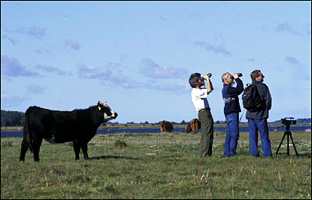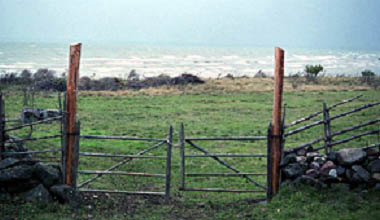|
Location
The area of Vainammeri is
located in Estonia, in the Eastern part of the Baltic
Sea between the major islands and the mainland. The
area represents a rural coastal zone with high nature
values.
Area description
Extensive beaches with widespread reed areas, coastal
grasslands and limestone plains represent habitats for
thousands of birds, mammal species and rare plants.
A shallow clean sea, where light reaches the bottom
along thousands of square kilometres and which also
contains a rich organic world. However, the Estonian
coastal landscapes have never been all natural. Humans
have inhabited the area over the last couple of centuries
and have developed their agricultural activities. Grazing
and mewing have always existed along the coastline.
During the second half of the twentieth century, degradation
of local coastal economies has led to the degradation
of many valuable habitats. The opened coastal areas
like wooded meadows, limestone meadows and extensive
coastal grasslands which are full of species have been
overgrown by bushes. To revive these types of ecosystems,
sensible management of ecosystems is needed in the first
place. Several Estonian non-governmental organisations
and the WWF-Sweden have initiated the Väinameri
project to restore and conserve seminatural coastal
ecosystems by assisting the local people in developing
small-scale economies. Main areas of the project applications
are in farming, handicrafts and eco-tourism. Awareness
building and ecological education are also considered
to be of high priority in this project.
|
|
|
Project Description
The ecotourism component is a part of a holistic approach
to sustainable nature use in the area. The idea of the
project is to some extent similar to the food chain
concept in ecology. Local inhabitants, through their
economic activities use various resources of the coastal
area by changing the landscape into a more diverse state.
The sustainable character of the human activities will
keep the agro-environmental system in equilibrium. By
assisting new practices in the coastal area, the Väinameri
project will support restoration of valuable areas,
but also lead to the improvement of social aspects.
|
|

Ecotourism, alongside with farming and handicrafts,
provides for re-creation of the viable coastal farmers
society, by creating extra income and divercification
of activities.

|
Results of the project
The project has resulted in a significant improvement
in coastal landscape management and the protection of
natural values. Thousands of hectares of valuable coastal
grasslands have been restored and are now managed by
more than 300 high quality beef cattle and sheep. New
jobs have been created in traditional handicrafts and
tourism industries within the local communities. Three
small businesses and several societies have been created
as a result of the project.
The main result of the project is the establishment
of the unformal co-operation network of actors which
encompasses about 100 people.
The project has carried out the following:
2900 hectar of coastal grasslands grazed, 2800 hectar
has been mowed and 110 hectar has been cleared of bushes.
The project has created 7 nature study trails and 4
demonstaration sites. Also, three different ecotourism
packages, which include bird-watching, botany, local
handicrafts, local food and accommodation have been
launched (www.arhipelaag.ee/vainameri/).
|